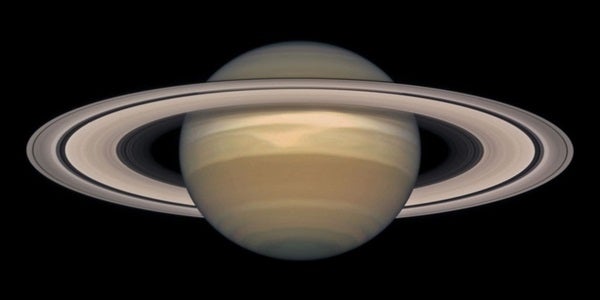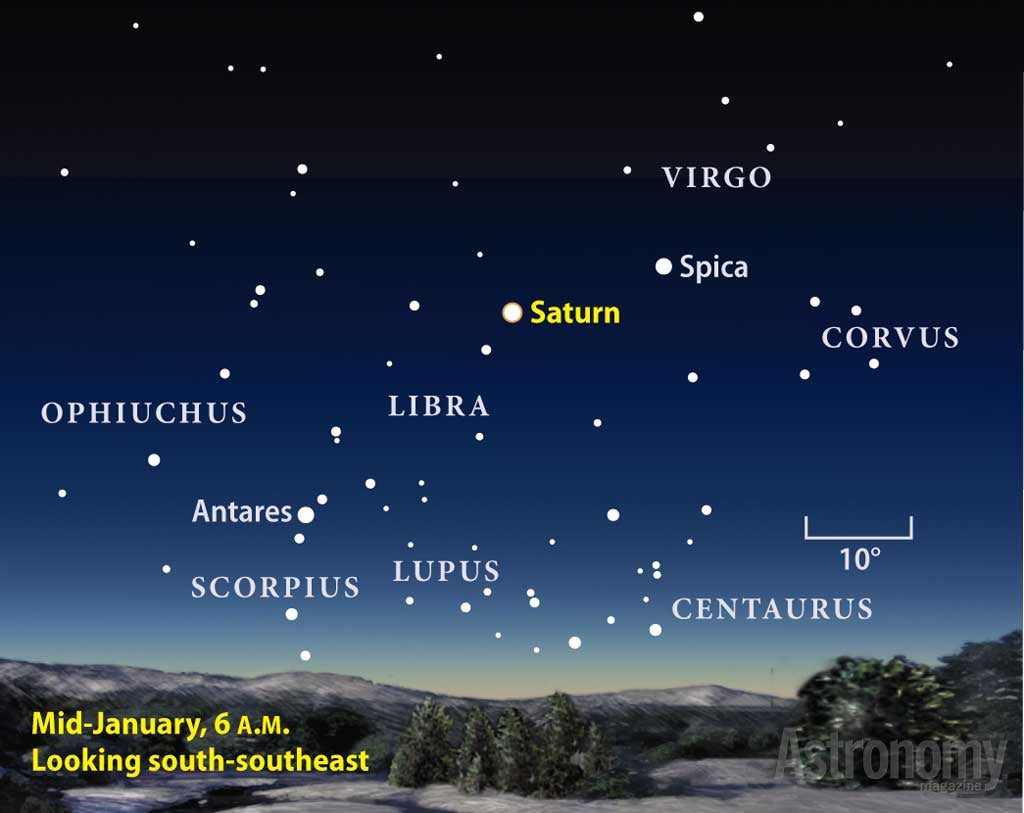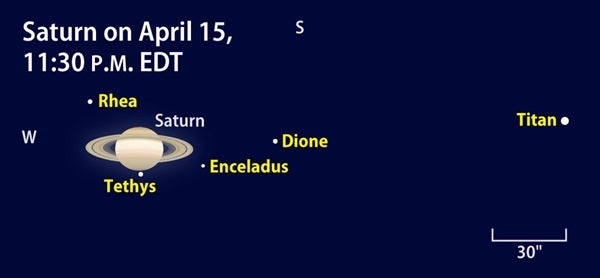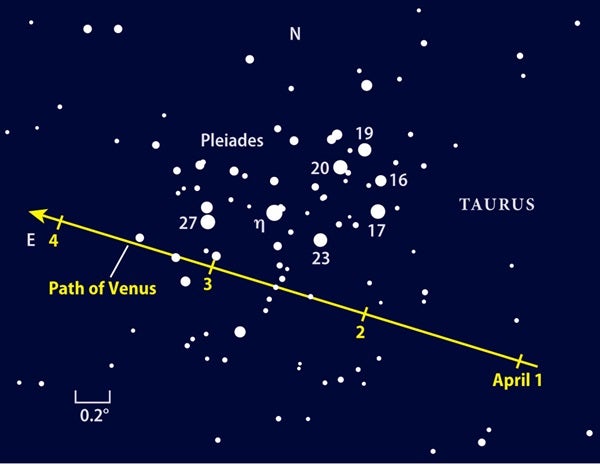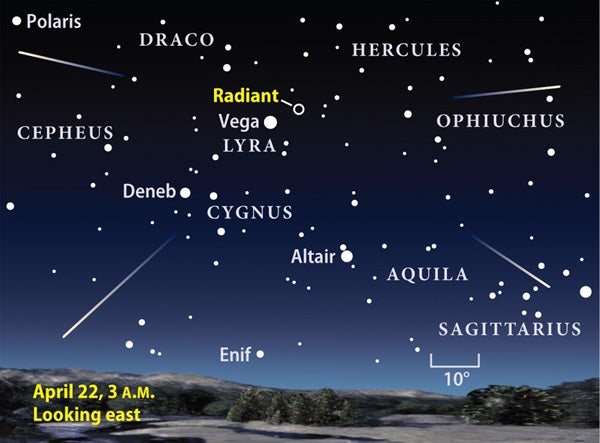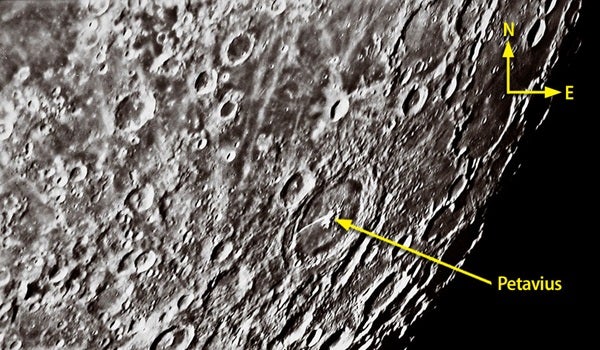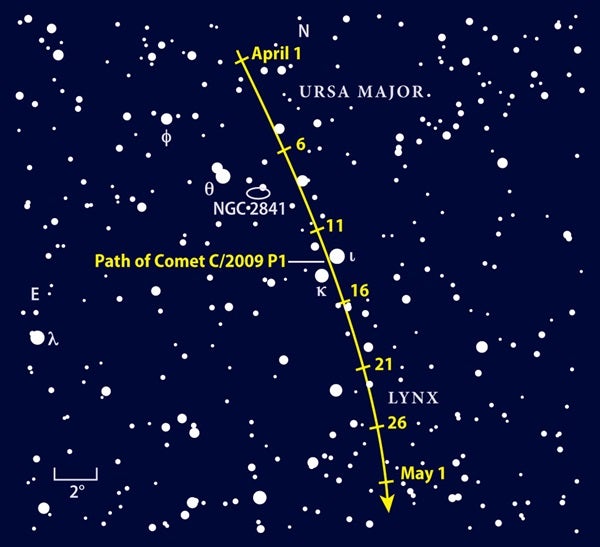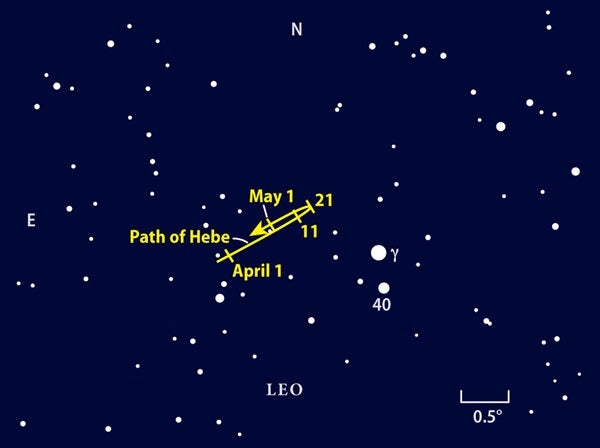Make your first target of the evening Jupiter. The giant planet hangs low in the west after sunset in early April. You can find Jupiter about 15° high one hour after the Sun disappears below the horizon. Shining brilliantly at magnitude –2.1, the planet stands out against the fading twilight colors. It remains on view until it sets around 10 p.m. local daylight time. A view through a telescope shows the gas giant’s 34″-diameter disk, which won’t reveal a lot of detail because of the low altitude.
With each passing night, Jupiter appears lower in the sky, a consequence more of the quickly advancing twilight on spring evenings than on anything the planet is doing. By the 15th, the giant world lies only 5° high an hour after sunset and dips below the horizon by the time twilight ends.
Jupiter disappears from view by the end of April as it heads toward its conjunction with the Sun in mid-May. But before it departs the evening stage, it has one final act worth noting. On April 22, a slender crescent Moon hangs just a few degrees above the planet in the bright twilight.
Look well above Jupiter and you can’t miss dazzling Venus. Earth’s planetary neighbor begins April only 1° below the famous Pleiades star cluster (M45). The view gets even better the following two nights when the planet passes through the cluster’s southern outskirts. On the 2nd, Venus lies 0.6° due south of 4th-magnitude Electra (17 Tauri). The following night, the planet passes 0.3° south of 4th-magnitude Atlas (27 Tau).
Venus shines at magnitude –4.5 during the encounter, which makes it 100 times brighter than the combined glow of all the cluster’s stars. The close pairing between the planet and the Pleiades promises to be one of the most engaging scenes in this spring’s sky. The best views will come through binoculars or a telescope operating at low power.
Venus stands so high in the west after sunset because it reached greatest elongation from the Sun in late March. The planet remains at least 40° east of our star throughout April and sets after 11 p.m. local daylight time. And as bright as it appears next to the Pleiades early this month, it grows even brighter. By the 30th, it gleams at magnitude –4.7, the brightest it gets during this evening apparition.
The view of Venus through a telescope changes dramatically during April. The planet comes much closer to Earth and its apparent diameter swells nearly 50 percent, from 25″ to 37″. Over the same period, Venus’ phase wanes sharply, dropping from nearly half-lit on the 1st to barely one-quarter illuminated on the 30th.
As darkness falls these April evenings, Mars stands two-thirds of the way from the southeastern horizon to the zenith. It dominates the background stars of its host constellation, Leo the Lion. The Red Planet shines at magnitude –0.4 at midmonth, easily besting Leo’s brightest star, Regulus. Mars moves westward relative to the starry backdrop until April 15, when it approaches within 4° of Regulus, before resuming its normal easterly motion.
Notice the vivid color contrast between Mars and Regulus. The former appears orange-red because its surface, which contains lots of iron oxide, or rust, reflects that color of sunlight. The latter shines blue-white because hot stars preferentially radiate that hue.
Now just one month past opposition, Mars is a fine object even through small telescopes. The best views come early in the month when the planet appears larger. Mars’ apparent diameter shrinks from 13″ on April 1 to a still-respectable 10″ by the 30th. Superior views also come shortly after darkness falls when Mars lies highest in the sky and its light passes through less of Earth’s image-distorting atmosphere.
The prominent dark feature Syrtis Major provides a good example. At 11 p.m. EDT April 7, Syrtis Major is just rotating out of view. At the same time April 13, it appears nearly dead center on the planet’s disk. And a week after that, Syrtis Major starts to rotate onto the visible disk at 11 p.m. EDT and remains in view until Mars sets around 4 a.m. local daylight time.
Saturn puts on quite a show in April. The ringed planet lies opposite the Sun in our sky on the 15th, which means it rises at sunset and remains visible all night long. An outer planet also lies closest to Earth at opposition and so appears brightest; in Saturn’s case, it peaks at magnitude 0.2. That makes it nearly a full magnitude brighter than Spica, the luminary of the planet’s host constellation, Virgo the Maiden. Spica lies 5° southwest of Saturn all month. A Full Moon appears near both the night of April 6/7.
The view of Saturn through a telescope impresses novices and seasoned observers alike. The planet’s disk appears noticeably flattened, measuring 19″ across the equator but only 17″ from pole to pole at opposition. (Saturn’s equatorial bulge arises from its gaseous nature and fast rotation.)
You should check Saturn’s disk for any possible storm systems. Although they are quite rare, a large one captured observers’ attentions last year. Even small instruments revealed it as a distinct white spot. It grew more elongated as it was buffeted by the saturnian atmosphere’s high winds.
But the true visual treat comes from viewing Saturn’s ring system, which looks pretty as a picture even through a small scope. The rings span 43″ on the 15th, more than double the planet’s disk, and tilt 14° to our line of sight. You should have little trouble spying the Cassini Division, a dark gap that separates the outer A ring from the broader and brighter B ring.
A good 4-inch telescope reveals a trio of 10th-magnitude moons. Tethys, Dione, and Rhea lie well inside Titan’s orbit and revolve around the planet much faster. (Tethys circles in 1.9 days, Dione in 2.7 days, and Rhea in 4.5 days.) You’ll need an 8-inch or larger scope to pick up 12th-magnitude Enceladus, which orbits in 1.4 days and never strays far from the outer edge of the ring system.
Perhaps Saturn’s oddest moon is two-faced Iapetus. One of its hemispheres is as bright as freshly fallen snow while the other is as dark as charcoal. And because it always keeps the same face pointed toward Saturn, earthbound observers see its brightness change by 2 magnitudes during its 80-day orbit. Look for it 2′ due south of Saturn on April 6 when it glows at 11th magnitude. Then follow it as it heads toward greatest western elongation April 26, when it shines at 10th magnitude and lies 9′ from the planet.
Distant Neptune returns to the morning sky in April. You can find it among the background stars of central Aquarius, low in the east-southeast shortly before dawn. Binoculars should bring the 8th-magnitude world into view.
Neptune’s 6th-magnitude sibling, Uranus, hangs even lower in the predawn sky. On April 30, it lies 6° above the eastern horizon 45 minutes before sunrise.
Mercury reaches greatest elongation April 18, when it lies 27° west of the Sun. Unfortunately, spring mornings are notoriously difficult for viewing planets. The innermost world appears just 4° above the eastern horizon 30 minutes before sunrise from midnorthern latitudes. It shines brightly at magnitude 0.3, however, so you might spy it through binoculars against the bright twilight.
Barring bad weather, early January’s Quadrantid shower gets the meteor-viewing year off to a rousing start. But then the sky settles down for a long winter’s nap. The longest meteor drought of the year doesn’t end until the Lyrid shower picks up in mid-April.
This shower remains active from April 16 to 25 but climbs to a fairly sharp peak the night of April 21/22. Under a clear, dark sky, observers typically spot about 20 meteors per hour at the peak. (Although rates have spiked as high as 90 per hour, that hasn’t happened since 1982.)
Conditions this year should be ideal. New Moon occurs April 21, so our satellite’s glare won’t be around to cause interference. The meteors appear to radiate from the constellation Lyra, which lies in the northeastern sky in late evening and passes nearly overhead shortly before dawn.
Probably 90 percent of lunar observers view the Moon during its waxing phase. The period between New and Full Moon coincides with the time our satellite hangs in the evening sky. As the phase wanes following Full Moon, our celestial neighbor doesn’t rise until late evening or after midnight.
Take some time this month to explore the practically unexplored country of a waning Moon. Lunar craters and wrinkle ridges take on a decidedly fresh appearance under these reversed lighting conditions. As the Sun sets over these features, it lights them from the western side. Their western flanks appear outlined in white, unlike the familiar black we see at lunar sunrise.
Although it is almost invisible in the days leading up to Full Moon, the crater Petavius is easy to spot in the lunar southeast late on the evening of April 7. The crater spans 110 miles, which makes it the biggest impact scar on this part of the Moon. Its center sports a complex of brighter peaks that stand above a distinct valley whose southern flank is lit up. The valley disappears under the rim’s shadow the next night as lunar sunset darkens this region.
Take a quick look farther north to Mare Crisium and view the snaking wrinkle ridges lined with white on their western sides and shadows on the east. Return to the area during the waxing Moon April 23 and compare your impressions. The shadow of Petavius’ central massif now reaches the bright western walls. Shadows retreat by the 24th to reveal the valley outlined by darkness instead of the light we saw in early April.
| When to view the planets | ||
| EVENING SKY | MIDNIGHT | MORNING SKY |
| Venus (west) | Mars (southwest) | Mercury (east) |
| Mars (southeast) | Saturn (south) | Saturn (southwest) |
| Jupiter (west) | Uranus (east) | |
| Saturn (east) | Neptune (southeast) | |
Comet C/2009 P1 (Garradd) has graced our Northern Hemisphere sky for a year now, going about its business in a consistent if not spectacular way. Although the comet is now cruising back to the depths of the solar system, it remains a nice sight throughout these spring nights. It rides high in the evening sky and stays visible from dusk to dawn, so you can target it whenever you’re observing. If it follows astronomers’ predictions, the comet should fade only from 8th to 9th magnitude in April. It may be a bit faint for binoculars to deliver good views, but a telescope shows it well.
Comet Garradd is now on a southward trajectory through the front legs of Ursa Major the Great Bear. It passes just 2° east of the magnitude 9.2 spiral galaxy NGC 2841 at the start of April’s second week. Many deep-sky observers rank this galaxy among the finest that French astronomer Charles Messier didn’t see.
Messier observed and recorded some 44 comets during his 18th-century observations, but he also turned up lots of other fuzzy-looking celestial objects. Because he was interested only in the comets, however, he compiled a catalog of the imposters so future observers wouldn’t be led astray. As you view Comet Garradd, compare its brightness, shape, and level of detail with NGC 2841. Would you mistake the galaxy for a comet?
Although the comet passes closest to the galaxy a couple of nights after Full Moon, it’s worth hopping back and forth between the two at other times as well. Each will provide more than a few minutes of interest. You might also want to target the visitor from the outer solar system the evening of April 13. That night, the comet passes between Iota (ι) and Kappa (κ) Ursae Majoris, which together represent one of the Great Bear’s feet.
Main-belt asteroid 6 Hebe rides on the back of Leo the Lion all month. This region lies high in the southeastern sky on April evenings, not far north of the blue-white star Regulus and the orange-hued planet Mars. Just like the Red Planet, the asteroid completes its retrograde loop this month and then starts heading eastward relative to the background stars.
This celestial dance keeps the 120-mile-wide Hebe within 1.5° of Algieba (Gamma [γ] Leonis), a lovely golden-orange pair that appears as the brightest star in the curve of Leo’s Sickle asterism. Pump up your telescope’s power past 120x to split this 4″-wide binary system. Beginners commonly mistake the secondary as 40 Leonis, a 5th-magnitude star less than a Moon’s width south of Gamma.
Next, nudge your scope east of Gamma and use the chart to pick out 10th-magnitude Hebe from the distant background stars. To positively identify the asteroid, you need to detect its movement. Hebe’s motionless masquerade around midmonth will make this task harder, but you should see it by April’s final week.
Martin Ratcliffe provides professional planetarium development for Sky-Skan, Inc. Alister Ling is a meterologist for Environment Canada.

